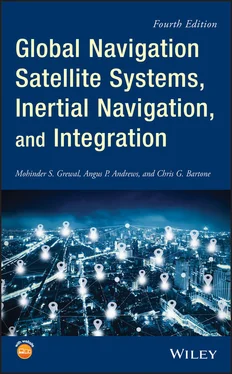1.2.2.3 Modernized GLONASS
The first of next‐generation GLONASS‐K satellites was first launched on 26 February 2011 and continues to undergo flight tests. This satellite transmits the legacy FDMA (frequency division multiple access) GLONASS signals and a L3OC code‐division multiple access (CDMA) signal at a frequency of 1202 MHz. Other GLONASS CDMA signals are under development within the legacy L1 (L1OC signal) and L2 (L2OC signal) bands.
The Galileo system is satellite‐based navigation system currently under development by the European Union (EU). This development has completed definition and development phases and is nearly complete with launching operational satellites to achieve a 30 satellite constellation. Galileo operates in the L‐band with MEO satellites at height slightly above the GPS MEO satellites (23 222 km for Galileo versus 20 180 km for GPS). Galileo satellites operate in three orbital planes at an inclination angle similar to GPS. Galileo operates in three spectral bands known as E1 (1559–1592 MHz), E5 (1164–1215 MHz), and E6 (1260–1300 MHz).
1.2.3.1 Galileo Navigation Services
The EU intends the Galileo system to provide various levels of services.
Open service ( OS ) . The OS provides signals for positioning and timing, is free of direct user charge, and is accessible to any user equipped with a suitable receiver, with no authorization required. The OS provides dual‐frequency operation in the L1/E1 and L5/E5 frequency bands. The Galileo E1 L1C signal centered at 1575.42 MHz is compatible with the modernized GPS L1C signal transmitted by GPS III satellites. The Galileo E5a signal at 1176.45 MHz is part of a combined AltBOC signal. Modernized GNSS receiver equipment may use a combination of Galileo and GPS signals, thereby improving performance in severe environments such as urban canyons and heavy vegetation.
Commercial service ( CS ) . The CS service is intended for applications requiring performance higher than that offered by the OS. Users of this service pay a fee for the added value. CS is implemented by adding two additional signals to the OS signal suite. The additional signals are protected by commercial encryption, and access protection keys are used in the receiver to decrypt the signals. Typical value‐added services include service guarantees, precise timing, multifrequency ionospheric delay measurements, local differential correction signals for very high‐accuracy positioning applications, and other specialized requirements. These services will be developed by service providers, which will buy the right to use the multifrequency commercial signals from the Galileo operator.
Public regulated service ( PRS ) . The PRS is an access‐controlled service for government‐authorized applications. It is expected to be used by groups such as police, coast guards, and customs. The signals will be encrypted, and access by region or user group will follow the security policy rules applicable in Europe. The PRS will be operational at all times and in all circumstances, including periods of crisis. A major feature of PRS is the robustness of its signal, which protects it against jamming and spoofing.
Search and rescue ( SAR ) . The SAR service is Europe's contribution to the international cooperative effort on humanitarian SAR. It will feature near‐real‐time reception of distress messages from anywhere on Earth, precise location of alerts (within a few meters), multiple satellite detection to overcome terrain blockage, and augmentation by the four low Earth orbit (LEO) satellites and the three geostationary satellites in the current Cosmicheskaya Sistema Poiska Avariynyh Sudov‐Search and Rescue Satellite Aided Tracking (COSPAS‐SARSAT) system.
1.2.3.2 Galileo Signal Characteristics
Galileo will provide 10 right‐hand circularly polarized navigation signals in three frequency bands. The various Galileo navigation signals will use four different navigation (NAV) data formats to support the various service supported by Galileo: F/NAV (Free NAV), I/NAV (Integrity NAV), C/NAV, and G/NAV (Galileo NAV). The I/NAV signals contain integrity information, while the F/NAV signals do not. The C/NAV signals are used by the CS, and the G/NAV signals are used by the PRS.
This band, which spans the frequency range from 1164 to 1214 MHz, contains two signals, denoted E5a and E5b, which are centered at 1176.45 and 1207.140 MHz, respectively. Each signal has an in‐phase component and a quadrature component. Both components use spreading codes with a chipping rate of 10.23 Mcps (million chips per second). The in‐phase components are modulated by navigation data, while the quadrature components, called pilot signals , are data‐free. The data‐free pilot signals permit arbitrarily long coherent processing, thereby greatly improving detection and tracking sensitivity. A major feature of the E5a and E5b signals is that they can be treated as either separate signals or a single wide‐band signal. Low‐cost receivers can use either signal, but the E5a signal might be preferred, since it is centered at the same frequency as the modernized GPS L5 signal and would enable the simultaneous reception of E5a and L5 signals by a relatively simple receiver without the need for reception on two separate frequencies. Receivers with sufficient bandwidth to receive the combined E5a and E5b signals would have the advantage of greater ranging accuracy and better multipath performance.
Even though the E5a and E5b signals can be received separately, they actually are two spectral components produced by a single modulation called alternate binary offset carrier (AltBOC) modulation. This form of modulation retains the simplicity of standard binary offset carrier (BOC) modulation (used in the modernized GPS M‐code military signals) and has a constant envelope while permitting receivers to differentiate the two spectral lobes.
The in‐phase component of the E5a signal is modulated with 50 sps (symbols per second) navigation data without integrity information, and the in‐phase component of the E5b signal is modulated with 250 sps data with integrity information. Both the E5a and E5b signals are available to the OS and CS services.
This band spans the frequency range from 1260 to 1300 MHz and contains a C/NAV signal and a G/NAV signal, each centered at 1278.75 MHz. The C/NAV signal is used by the CS service and has both an in‐phase and a quadrature pilot component using a BPSK spreading code modulation of 5 × 1.023 Mcps. The in‐phase component contains 1000‐sps data modulation, and the pilot component is data‐free. The G/NAV signal is used by the PRS service and has only an in‐phase component modulated by a BOC(10,5) spreading code and data modulation with a symbol rate that is to be determined.
The L1/E1 band (sometimes denoted as L1 for convenience) spans the frequency range from 1559 to 1591 MHz and contains a G/NAV signal used by the PRS service and an I/NAV signal used by the OS and CS services. The G/NAV signal has only an in‐phase component with a BOC spreading code and data modulation. The I/NAV signal has an in‐phase and quadrature component. The in‐phase component contains 250‐sps data modulation with a BOC(1,1) spreading code. The quadrature component is data‐free and utilizes a combined BOC signal.
The BeiDou Navigation Satellite System (BDS) is being developed by the People's Republic of China (PRC), starting with regional services and expanding to global services. Phase I was established in 2000. Phase II (BDS‐2) provides service for areas in China and its surrounding areas. Phase III (i.e. BDS‐3) is being deployed to provide global service.
Читать дальше












